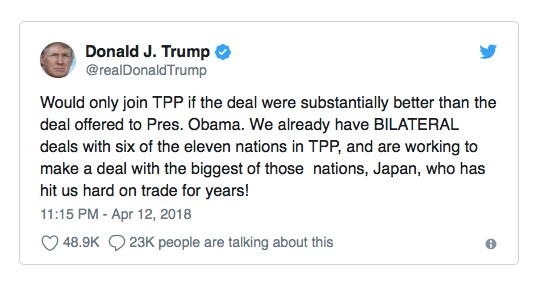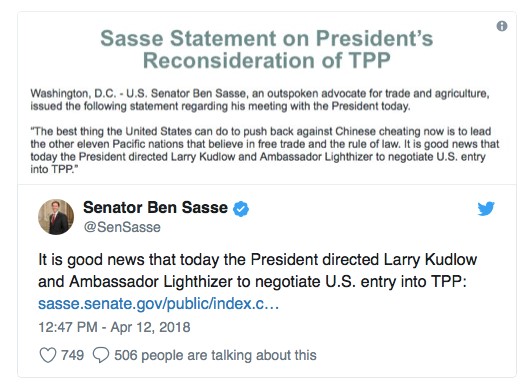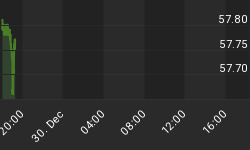At this point in the trade war game, the only thing that’s clear is that venting isn’t policy, and what was said yesterday may mean nothing today.
More than a few eyebrows were raised when Trump called for America to join the same Trans-Pacific trade pact that he was so staunchly against just last year.
But, no matter: Hours later this was already a different story.
After a few nasty headlines, Trump did another 360, saying the U.S. would only join the pact if the terms were improved.

(Click to enlarge)
In June last year, Trump said: “The Trans-Pacific Partnership is another disaster done and pushed by special interests who want to rape our country, just a continuing rape of our country. That’s what it is, too. It’s a harsh word: It’s a rape of our country.”
On Thursday, Trump reportedly asked his top trade official to negotiate re-entering the Trans-Pacific Partnership (TPP), telling national economic council chairman Larry Kudlow to “get it done”.
But while some suggest it’s an odd time to want to rejoin a trade pact, everyone needs to remember that this is Trump’s negotiating tactic. In fact, there’s never been a better time to join the TPP.
Yes, there might be some concerns that some of the members of the TPP are being threatened with additional U.S. tariffs, and on the surface pact members-- including Japan, Australia and New Zealand—don’t seem particularly enthusiastic about the prospect. But America is the butter on this bread.
Some feel that, after cutting and running on this pact earlier, Washington is now operating with less negotiating leverage, and pact members would seek more concessions, not fewer.
Japan has already intimated that the pact won’t be revisited with an eye to major changes.
“It’s difficult to bring part of the pact and renegotiate it,” the New York Times quoted Japanese chief cabinet secretary Yoshihide Suga as saying.
But this may not be the reality. Related: Tech Giants Could Be First Victims Of U.S. Trade War
In February 2016, the 12 countries bordering the Pacific Ocean signed up to the TPP in a deal that represents 40 percent of the world’s economic output. The goal was to deepen economic ties, cut tariffs, foster trade and boost growth. The end game is the creation of a new single Pacific Ocean market, like the European Union’s—only much bigger, and much better. In other words, a bulwark against China.

(Click to enlarge)
But whether Washington really has less leverage now remains questionable. Some would argue that the U.S. was the key to this deal, and without it, the TPP had to scale down its ambitious considerably. Plenty think the TPP members will negotiate with Trump, even if they attempt to save face with sour expressions in the meantime.
U.S. politicians who welcomed the initial call to rejoin the TPP are ignoring the apparent reversal hours later:

(Click to enlarge)
An unnamed senior administration official told the Washington Post, more or less, that this is another negotiating tactic, and a message: “[…] the White House is approaching potential new talks as a way to make signal that Trump is receptive to free market proposals if he feels they can be reached in a way that advances U.S. interests.”
“[…] now that he’s moving toward serious negotiations with China, this is the best defense against the Chinese and the best way to counter them in the Pacific,” American Enterprise Institute’s Claude Barfield told the Washington Post.
The big take away here, is the timing of the initial announcement, even if it was backtracked. According to the Wall Street Journal, it signals that the administration is confident that China has “bended to its will”.
By Fred Dunkley for Safehaven.com
More Top Reads From Safehaven.com:

















